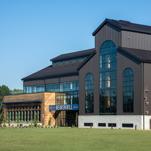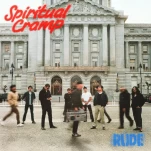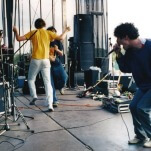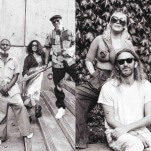Heaven Hill’s Bardstown Homecoming Places a Big Bet on Bourbon’s Future
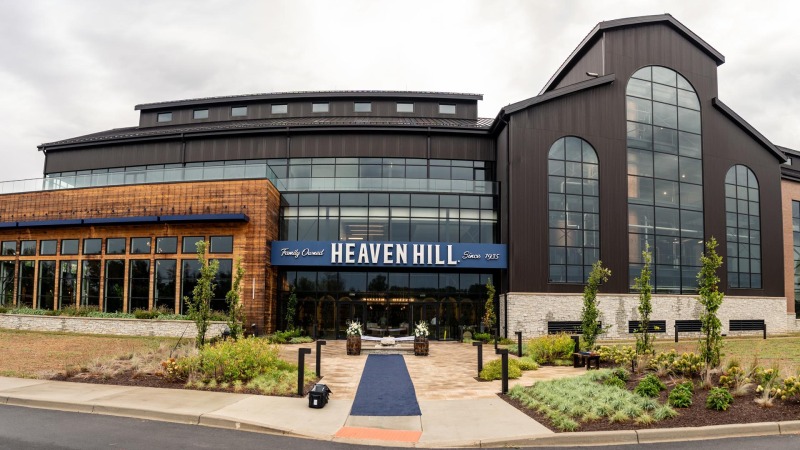
It was nearly 30 years ago, in November of 1996, when Kentucky bourbon powerhouse Heaven Hill last distilled their flagship whiskey brands in the company’s hometown of Bardstown, Kentucky. Amidst a thunderstorm and driving rain and wind, in the distillery that had produced every drop of bourbon since the company’s founding in 1935, building the Heaven Hill name into an industry leader over the course of six decades, cries of alarm were going up. A fire had somehow sparked in one of the whiskey aging warehouses (a cause has never been conclusively determined) that studded the distillery campus, and the flames were spreading. What followed was one of the industry’s most costly, devastating disasters: The Heaven Hill distillery fire of Nov. 7, 1996.
Driven by the gusting winds, the fire leapt from one rickhouse to the next, as more of the wooden structures were kindled. The rain did little to help; not once the flames began to ignite barrels of aging whiskey. Eyewitness accounts described barrels exploding and rocketing through the sky like fireworks. Barrel hoops melted into huge piles of fused metal. Worse still, when the rickhouses began to collapse, a newly released flood of burning alcohol flowed like a river of flame in the direction that gravity would take it … directly toward the Heaven Hill production distillery. When the smoke cleared the next day, nearly 100,000 barrels of aging whiskey had been destroyed, along with the distillery where that whiskey had been produced since the end of American Prohibition. Given the lower overall level of whiskey production in the 1990s, the amount of destroyed booze equaled roughly 2% of the entire world’s bourbon supply, likely the most ever lost in one disaster.
It was the sort of catastrophic blow that would have meant the end of many major companies, but not Heaven Hill. Just short of three decades later, the company has made good on its long-pondered plans to bring whiskey production back to Bardstown, opening a state-of-the-art new $200 million facility, the Heaven Hill Springs Distillery. It’s both a symbolic rededication to the city of its infancy, and a big bet that the company is making on the future of bourbon as a segment of the struggling beverage alcohol market. Heaven Hill is betting on itself; on its beloved brands, at a time when many other companies are planning conservatively and pulling back production. Whiskey is now flowing from the stills in Bardstown once again, and the company plans to do a whole lot more growing here in the years to come.
A New Face of Heaven Hill
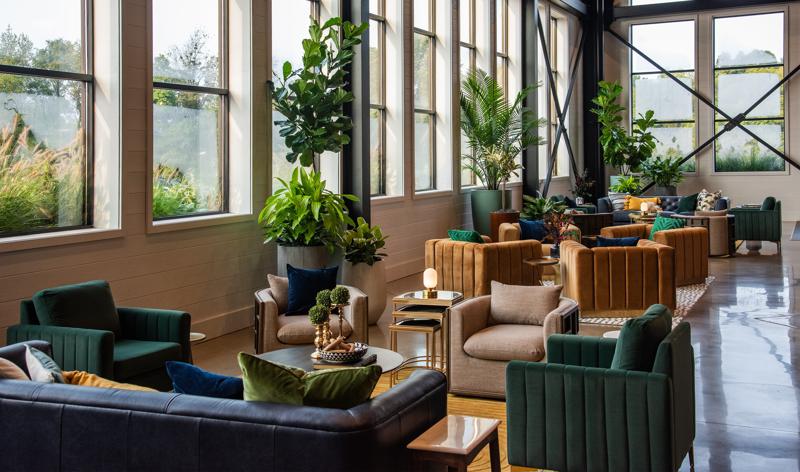
The Heaven Hill Springs Distillery has been envisioned, since the start, as a place for current Master Distiller Conor O’Driscoll (in the role since 2019) to pursue his creative ambitions, designed from the ground up not just as a place to expand production of existing Heaven Hill products but to workshop new ones that might not have been possible before. It’s meant to be a more flexible facility; one with built-in room for expansion, and presumably the place where O’Driscoll will make his most profound contributions to the Heaven Hill legacy.
At the same time, the distillery will allow public access in a way that no other large scale Heaven Hill distillery has ever been able to accommodate. The existing Heaven Hill Bourbon Experience in Bardstown may have a restaurant and bar, but it’s never been a functioning distillery. And the Bernheim distillery in Louisville, meanwhile, where the company has made the vast majority of distillate since purchasing it from United Distillers/Diageo in 1999, was never designed with a public-facing welcome center or tasting room ethos in mind. For a long time, through the heart of the bourbon boom, that has meant that the opportunity to visit a working Heaven Hill distillery has been limited to the Evan Williams Bourbon Experience on Whiskey Row in Louisville, but this is a micro-facility rather than the grand, impressive factory a consumer would probably expect from the country’s largest, independent, family-owned bourbon producer. The Springs Distillery is finally changing this, becoming the keystone symbol of Heaven Hill’s consumer-facing whiskey production; a centerpiece worthy of a company that has been one of the biggest names in bourbon for so many decades.
That said, there are some quirks to production here that set the Springs Distillery apart from what will continue to be done at Bernheim every day. For one thing, the Springs Distillery has the facilities to propagate Heaven Hill’s own proprietary live yeast strain, unlike the dry yeast that is used at Bernheim. Another odd detail: The facility has currently been producing whiskey with the sweet mash method while it gets its dry house and backset tank up and running, to then switch over to the more common sour mash method. These are the kinds of seemingly tiny differences that could theoretically lead to variations in the flavor profile of otherwise familiar Heaven Hill whiskey mash bills, which requires the attention of O’Driscoll and other sensory testers to keep in a place that is standardized and familiar–no one wants their next bottle of Evan Williams or Elijah Craig to suddenly taste different. Regardless of where it’s distilled, all Heaven Hill whiskey will continue to be barreled in Bardstown, before coming to rest at various Kentucky rickhouse sites.
In terms of sheer scale, the Springs Distillery is already a beast of a facility, made all the more impressive by the fact that one can clearly see the various spaces that are earmarked to expand its production capacity even more. Its centerpiece is a 60-foot Vendome copper still, capable of producing more than 33,000 gallons of spirit per day. To feed that still, there are currently 10 fermenters on site that each hold 90,000 gallons–by the time the company hits the further off third phase of expansion, that number would be more than two dozen. And by the way, if you’re having trouble picturing just how much volume a 90,000 gallon fermenter actually equates to after distillation and aging, the company says that any given one of those fermenters will ultimately produce roughly 7,000 bottles of bourbon cut to the proof of Elijah Craig, each time it’s filled. All in all, the facility opens with an initial capacity of 150,000 barrels per year, with a future capacity that could be as high as 450,000 annual barrels.
“You don’t lead a distillery like this without understanding the shoulders you stand on,” said O’Driscoll in a press statement, keenly aware of the prestigious history of Heaven Hill master distillers that he has joined. “This facility is a tribute to the craftsmanship and care that came before me and a promise that we will continue to live up to those standards, while advancing the science, sustainability, and innovation that today’s whiskey world demands.”
A Whiskey Bottle Half Full?
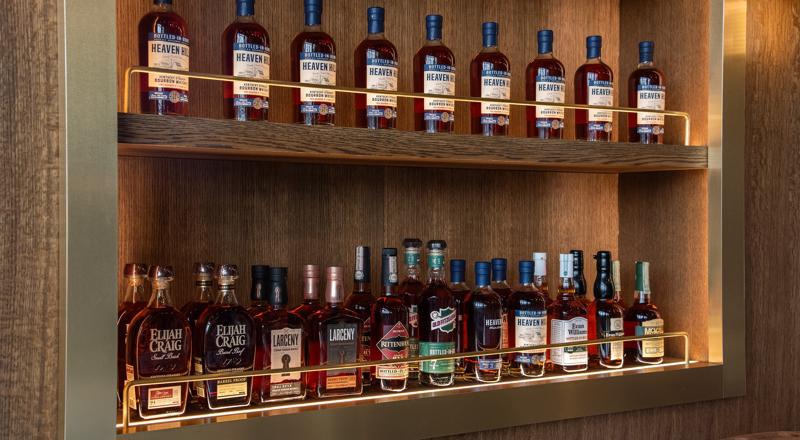
You can’t discuss the decision to open a massive, $200 million new Kentucky whiskey distillery without noting the rampaging elephant in the room: The American beverage alcohol market is in the shakiest territory it’s seen in the last few decades. The reasons for the industry wide slowdown are myriad, from a cultural rise in alcohol abstinence and health-conscious decision making, to the growing popularity and accessibility of cannabis as a partial alcohol replacement, to the effects of GLP-1 weight-loss medications, to the unpredictable and capricious applications of blanket tariffs by the Trump administration. Perhaps the most salient issue is simply one of pure economics: More Americans are feeling the pinch of financial scarcity, and cutting back on their discretionary spending. Still others have traded down, through the various super-premium, premium and sub-premium tiers, landing on new regular purchases that are less expensive. And American whiskey, despite more than two decades of raucous growth, has not been immune to the pullback. For many companies, large and small, the lean times are here.
In the U.S., sales volumes of American whiskey (which includes bourbon, Tennessee whiskey, rye whiskey, etc.) reversed in 2023 for the first time in more than 20 years, dropping 1.2% in total volume according to industry data tracker IWSR. The drop only accelerated in 2024, with overall American whiskey volume down an estimated 4% through the first nine months of the year. Data for 2025 isn’t yet fully available, but the declines seem to have continued … and coupled with the industry’s ever-ramping production capacity in recent years, this means that more bourbon than ever has found itself sitting in warehouses aging. In other words, a classic glut of supply. Which is perhaps not the moment that you expect to see one of the industry’s biggest names unveiling a facility that can fill hundreds of thousands of additional barrels per year.
Heaven Hill, however, is attempting to provide for its future with the Springs Distillery, looking past the headlines and current tumult of the beverage alcohol world while anticipating that both they and their peers will adjust to meet consumers where they are. The company’s co-president, Kate Latts, the daughter of Executive Chairman Max Shapira, who has been with Heaven Hill for just about half a century, acknowledged at the distillery’s opening that the company has its eyes on the horizon, benefitting from its scale.
“As an independent, family-owned company, we’ve always had the freedom to take the long view,” Latts said. “Heaven Hill Springs Distillery is a long-term, generational investment in our brands, our people, and our place in Kentucky. It’s designed not just for today’s whiskey, but for the future of American whiskey.”
As a scion of the original five brothers of the Shapira family who founded Heaven Hill in 1935 to capitalize on the need for a new supply of American whiskey following the repeal of Prohibition, Latts has certainly had as close and detailed a view of the bourbon boom era as anyone. As a child, she recalls her first distillery job of stuffing $2 bills into envelopes as part of an early mail-in rebate program, and now, decades later, she’s one of the people most closely tasked with shepherding those same brands through the industry’s slowdown. The risks are obvious, but it’s the elemental strength and consumer recognition of those marquee brands–Evan Williams, Elijah Craig, Parker’s Heritage, etc.–that Latts and her father say give them confidence to continue planning for growth, even when the headlines are frightening. They have faith in the brands that made the company a household name.
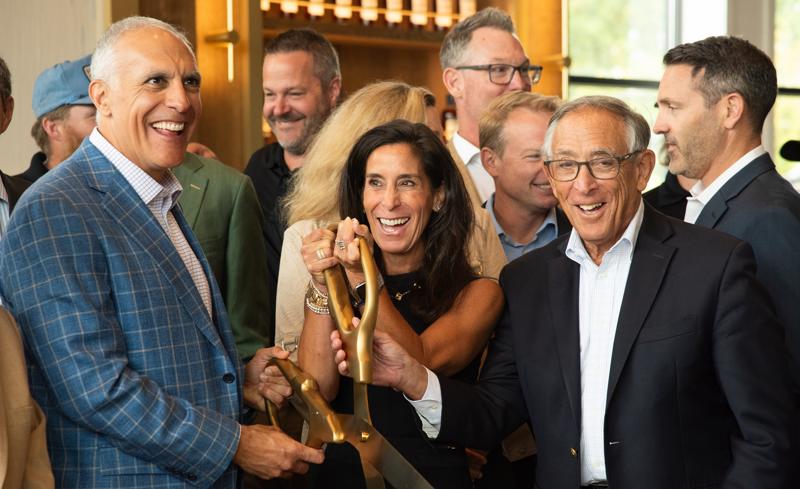
And not to be lost in the shuffle: There’s still the potential for more breakthrough brands to come, drawing perhaps upon the company’s long history and the other, more frequently forgotten brands in its stable. In the last decade, the obvious example of this kind of reinvention would be the Old Fitzgerald brand of wheated bourbons, which went from being a bottom shelf afterthought of many consumers, to one of the era’s most hotly desired limited release bottles following a bottled-in-bond redesign into its now signature, beautiful decanter bottles. With Old Fitz, Heaven Hill effectively took a legacy brand out of the past that had very little remaining cachet, and reinvented it as something that drinkers everywhere ended up hunting; a marketing masterpiece if there ever was one. Who’s to say that a similar type of reinvention couldn’t ultimately be in the works for other history-laden brands under the Heaven Hill banner such as J.T.S. Brown or JW Dant? Who knows what formerly forgotten brand the bourbon geeks could be hunting in 2030?
Regardless, there’s no overstating the symbolic, mythic significance of Heaven Hill finally returning its production–and the accompanying economic stimulus–to Bardstown, 30 years after the kind of fiery disaster that would have been the postscript for so many other companies. It probably didn’t feel like it at the time in 1996, but the best days for Heaven Hill were still ahead of it. As the Springs Distillery ramps up production and begins welcoming guests on the Kentucky Bourbon Trail throughout 2025, Heaven Hill will hope that the same sentiment will apply to the next three decades and beyond.
Jim Vorel is Paste’s Movies editor and resident genre geek, who has also spent years writing on alcohol, spirits and cocktails. You can follow him on Twitter or on Bluesky for more film and occasional drink writing.


